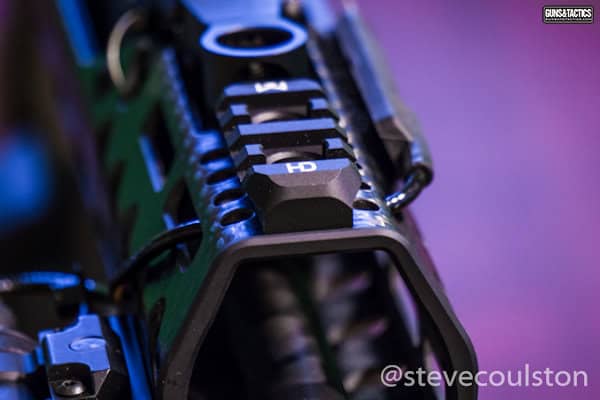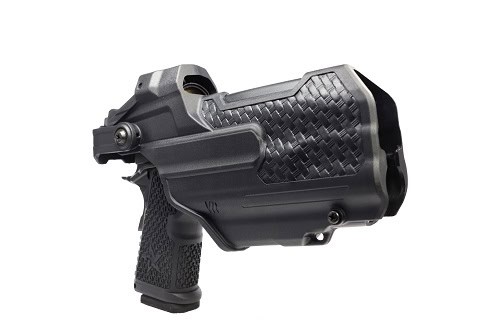SureFire SOCOM-4 Series—A New Fighting Suppressor
Fountain Valley, CA—SureFire, LLC, manufacturer of the world’s finest—and most innovative—illumination tools and…
Fountain Valley, CA—SureFire, LLC, manufacturer of the world’s finest—and most innovative—illumination tools and…
Shinenyx—creators of a cutting-edge fusion of digital night vision and thermal imaging technology—has…
German Precision Optics’ Passion APO is a high-performance compact spotting scope designed and…
The Mod-Navy Qual I’ve been doing this qual (or drill, or whatever the current nom…
• Built for road trips and off-road use• Manual transmission equipped• Wrapped in MultiCam Arctic…
I designed the Button Man to give shooters a low-round-count, low-light-engagement drill that involved both…

Steve Coulston takes time to speak to the founder of Handl Defense, Alan Handl.
We have much respect for all the innovators and dreamers out there. The guys and gals that have a dream and are willing to go the distance to make that dream a reality. They know full well it could cost them in more ways than one. Recently, we caught up with dreamer and innovator Alan Handl, founder of Handl Defense. He was kind enough to give us a history lesson, a tour of Handl Defense’s new facility, and got us up to speed on what they have been up to.
Alan like a lot of dreamers began small. Like really small. Handl Defense was born in a cramped, second story apartment in 2008 with nothing more than an idea, a workbench, and a Snap On tool box. Alan didn’t have fabrication nor engineering experience so he resorted to teaching himself how to computer model, prototype, and machine. Even still, he needed the services of outside design and machine groups for much of his parts manufacturing.
He remembers on one occasion he explained a firearms related concept to a machinist and hands him a magazine for a prototype. Taking the magazine the machinist tries to insert the magazine into the receiver… upside down and backwards. This machinist was a smart guy and an expert in his field. He just didn’t know firearms. That’s a big problem when you are trying to innovate in the firearms industry. Handl thinks, “This is stupid. There are real genius machinists out there, but I think guns are a completely different animal.”
"There are real genius machinists out there, but I think guns are a completely different animal."
Why the FNH SCAR? Handl chose the SCAR 17/MK 17 as the foundation for his fledgling business venture for a few reasons:
“When I first saw it come out in 2004 I thought it was pretty cool. Then SOCOM signed the contract for it to become their official battle rifle. It was at that point I knew it was going to stick around… I saw the proprietary magazine and thought to myself, ‘What are they using now?’ They are using the Knights Armament M110. OK, so it makes no sense to use a proprietary magazine. Also I viewed the polymer lower receiver as an anomaly. Never once in military history have they ever used a main stressed component made of polymer. In order to see the future you have to understand the past.”
The first product Handl Defense offered was the SCAR25 lower receiver for the SCAR 17 and MK 17 Mod 0 battle rifle. According to Handl, the SCAR 25 was basically a long shot. He says, “It was basically an 80 yard field goal. Kick it and hope you make it.” And it did.
The project started as an SR25/M110 magazine compatible, non-polymer lower. During the development process, Handl discovered a lot of issues with the platform. For example, unlike an AR, the rear end of the SCAR lower receiver floats as it is not pinned to the upper receiver. The upper and lower are only pinned together at the front. Handle noted, “So what ends up happening when the weapon recoils there is excessive forces being transferred to the lower which results in stress fractures and breaks.” He also mentioned the pistol grip on a polymer lower is susceptible to breakage if dropped or fallen on. Or the trigger pins break the polymer on the lower.
"We aren’t here to bash anyone’s reputation or get in a pissing match online. We are here to do what we do, and hopefully the customer will see that."
Development of the SCAR 25 wasn’t without its growing pains. There were quality control issues that unfortunately were not caught and a handful of out of spec SCAR 25 lowers went out to the consumer market. It didn’t take long to figure out what happened and the problem was dealt with as were the customers. Handl stated that:
“Everyone who had a defective lower has been taken care of no questions asked. We either fixed their lower or replaced it all together. We never stopped developing the SCAR25 and there have been a lot of modifications to it. It is the most complicated part of the weapon… and is the biggest challenge. There are a few competitors out there but they don’t know what we know. We aren’t here to bash anyone’s reputation or get in a pissing match online. We are here to do what we do, and hopefully the customer will see that.”

After the release and refinement of the SCAR25, the SCAR program still needed some TLC. Alan informed me:
“From there we got reports of the stock hinge breaking.”
“The factory stock hinge breaks around 60 lbs. of pressure. Ours, breaks at 120 lbs. of pressure. But that’s not the big problem as the stock will break before the hinge.” Handl has taken high speed video that shows the factory hinge beating like a heart when the rifle is shot which makes the hinge act like a trampoline, affecting the way the rifle reacts during the firing cycle.
Handl received more feedback from the field regarding heat issues, resulting in cook offs and burns. There is poor heat dissipation in the factory rifle. On top of that, thanks to the reciprocating charging handle and the short handguard there wasn’t room for accessories or a place to put the shooters support hand. Both the heat issue and the lack of rail space prompted Handl to start development on a new handguard for the SCAR series of rifles. That development took about 2-1/2 years.

The primary issue Handl was having with the handguard was with the resin used to make the handguard. He found that most resin he came across was melting around 300 degrees Fahrenheit. If one doesn’t exist, develop your own and that’s what Handl did. He states, “The resin we developed using a proprietary formula can withstand temperatures upwards of 1,000 degrees. And even then it doesn’t melt. It might deform, but it won’t melt” Impressive. This eliminated the need for a heat shield which is additional weight savings. This author has personally shot the SCAR 16 and 17 with the Handl handguard installed doing full auto mag dumps and the handguard was barely warm to the touch, while the barrel is smoking hot. It works.
Weight requirements are important. So in the case of the handguard, the Handl version has much more length and real estate compared to the FN offering. That being said, even thought it only weighs ounces lighter, the weight is moved rearward so the perceived difference is very noticeable. Your humble author was one of the first to have the opportunity to shoot a SCAR with the handguard installed and it is a remarkable difference. It literally feels like a different rifle.
Handl settled on Magpul M-LOK cut outs and rail sections for their rail. Not because they necessarily support only M-LOK, rather it was the best solution for the material they were working with. Handl also made sure to note that other than the FN handguard, theirs is the only handguard (that he knows of) that will support the FN-GL1 grenade launcher. Just in case any readers were in the market… It should also be noted Handl will be renaming their handguards from “Short”, “Standard” and “Long”, to “Carbine”, “Rifle” and “Extended” respectively.

The SCAR also needed to be able to handle maritime environments. This meant the rifle should be able to drain water, withstand corrosion and work in salt water environments. The SCAR program came a few years after this author left the Navy, however keeping our firearms up and running in a salt water environment was a big deal. The FN SCAR should have that figured out, right? I mean it has the Navy MK 17 designator for crying out loud. To find out, Handl took the SCAR SCUBA diving in the Puget Sound. After spending some time diving down at 60 feet, the weapons were washed down with fresh water, dried, oiled and put away in a conditioned environment. When he came back a few days later he found that literally all the metal internals were rusted. W…T…F… Over?!
“Why does it have parts that corrode?” Handl asked. He went on to say, “That is why the metal parts we make are all stainless steel with anti-corrosive properties.” They also offer a maritime parts upgrade kit to replace existing factory parts that are prone to rust and corrosion.
Speaking of corrosion, Handl discovered that the gas jet, located in the gas block, was corroding and eroding. They have had to drill out their fair share of jets to get them out. This author can attest to that and witnessed corrosion and seizure in his personal SCAR 17 gas jet. Handl developed an upgrade made from 316 stainless steel and can be serviced with a 2.5 mm Allen wrench.
Alan Handl has displayed a level of knowledge and expertise that only comes from making one’s work a passion. As an innovator and dreamer, he has found design flaws, traced them back to their origins, and start from scratch.
Next week, Steve Coulston continues to dig into the evolution of Handl Defense and what projects they plan to unveil to the gun world.



* The views and opinions expressed on this web site are solely those of the original authors and contributors. These views and opinions do not necessarily represent those of Guns & Tactics Magazine,
the administrative staff, and/or any/all contributors to this site.
Steve is a former United States Naval Special Warfare Combat Crewman (SWCC), NRA Life Member and has been a firearms enthusiast for over 30 years. Steve is a writer and photographer focusing on the testing and evaluation of new products and has a natural gift for breaking things. He resides in the Pacific Northwest with his wife and children enjoying the shooting sports and the great outdoors.

Staccato and Blackhawk announced the release of the T-Series Red Dot Sight (RDS) Duty Holsters built specifically for Staccato 2011 pistols.
[dcs_img_center framed=”no” w=”600″ h=”399″] http://gunsandtactics.wpengine.com/wp-content/uploads/2013/08/airborne-600-399.jpg [/dcs_img_center] [dcs_post_top] [dcs_fancy_header color=”#000000″ fweight=”bold”]2-325 AIR, 82nd Airborne plays host to Secretary of Defense and Purple Heart recipient Chuck Hagel to demonstrate the…

Spooky savings this weekend! Save 25% on in stock Vertx, Tasmanian tiger and Snugpak at U.S. Elite. Check it out.
Chris Tran introduces us to 212 Tactical Designs and the Tactical Belt Clip System Police officers in this day and age have an ever-growing responsibility towards the citizens…
The New Zealand Defence Force (NZDF) has agreed to an operating lease of a suite of SitaWare Command & Control (C2) software through Systematic’s in-country partner, Eagle Technology….

Oliver North shares his perspective on leadership and support for the Second Amendment. Filmed on location at the 3-Gun Nation “Rumble on the Range”in Las Vegas on on…
© 2025 UN12 Magazine
© 2025 UN12 Magazine
Wait! Don’t forget to